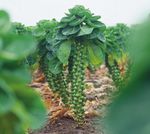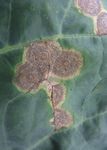BRASSICA DISEASE UPDATE 2021 - Syngenta UK
←
→
Page content transcription
If your browser does not render page correctly, please read the page content below
TECHNICAL UPDATE • BRASSICA
BRASSICA DISEASE UPDATE 2021
SYSTEMIC DOWNY MILDEW
Although all vegetable brassicas can be infected with Downy mildew
(Hyaloperonospora brassicae), especially at the small plant stage, it is not
normally a significant issue in most crops. Exceptions to this are broccoli and
cauliflower where the incidence of infection in mature heads has increased in
recent years. This may be partly due to varietal susceptibility.
Infection at any stage during the plants growth can result in systemic symptoms
later on in the growing head. The resulting black patches and streaks are
cosmetically undesirable especially when the head is floretted.
CULTURAL CONTROL
• Choose a tolerant variety which does not express symptoms in the head
• Ensure good disease control during propagation
CHEMICAL CONTROL
• Monitor crops for disease presence on leaves during vegetative growth
• Identify high risk periods - warm, wet weather with high humidity
• Consider varietal susceptibility as a risk factor
• Treat crops when disease is seen moving up the canopy
Systemic Downy mildew infection in broccoli
REVUS will give reduction of Downy mildew. Best results are seen when REVUS
is applied to at risk crops during early growth, five weeks post planting. Where
crops are stressed and waxy, including an approved adjuvant oil will improve
efficacy.
MAPP No.: 17443
ss Approved use: Broccoli/calabrese, Brussels
sprouts and cauliflower
Disease spectrum: Reduction of Downy mildew
Maximum individual dose: 0.6 l/ha
Maximum number of applications: 2
Minimum spray interval: 10 days
Latest time of application: 14 days
Other specific restrictions: For outdoor crops
and protected crops that are grown under a
temporary cover, the maximum total dose must
not exceed 1.2 litres product/ha/year on any
single area of land
Downy mildew infection on the leafOTHER IMPORTANT FOLIAR DISEASES
OF BROCCOLI
Broccoli is also susceptible to infection from White blister (Albugo candida) at or
close to maturity. Infection of the buds can be very visible and causes crop loss.
This disease requires only short periods of leaf wetness at warm temperatures -
morning dews during hot weather represent a high disease infection risk.
CULTURAL CONTROL
• Choose a tolerant variety to reduce risk
• Monitor crops in the area to gather data of disease pressure
• Sign up to Brassica Alert for weekly disease updates
CHEMICAL CONTROL
AMISTAR gives moderate control when used as a preventative treatment. As the
risk of crop loss increases and once the head is present, the following strategy White blister infection on the head
should be considered where both diseases are an issue. of broccoli
STRATEGY FOR CONTROL OF SYSTEMIC DOWNY MILDEW AND
WHITE BLISTER IN BROCCOLI
Weeks Post Harvest
Focus Recommendation MAPP No.: 18039
Planting Interval
Approved use: Brussels sprouts, cabbage,
5 Systemic Downy mildew REVUS 14 days cauliflower, kale (winter greens), collards (spring
greens), broccoli and calabrese - all outdoor
7 White blister AMISTAR 14 days Disease spectrum: Moderate control of White
blister, Ring spot and Alternaria spp
Maximum individual dose: 1.0 l/ha
RESISTANCE MANAGEMENT
Maximum number of applications: 2
To minimise the risk of resistance developing, CAA fungicides (REVUS) may be
Minimum spray interval: 12 days
applied in formulated/tank mixture or alternating strategy using fungicides from
Latest time of application: 14 days before
different mode of action groups which are effective against Downy mildew. Use
harvest
in alternation with fungicides with another mode of action is recommended.
Aquatic buffer zone: LERAP B
CAA fungicides should make up no more than 50% of the total number of
Other specific restrictions: A maximum
fungicide applications per crop or season. total dose of 500 g azoxystrobin must not be
exceeded within a 12 month period on the same
FOLIAR DISEASE field
Timing and Monitoring: Regular crop monitoring and the use of forecasting
and disease monitoring such as Brassica Alert are recommended to help
optimise fungicide timing. The focus on disease control will vary with crop type and timing. The following highlights likely high risk
periods by disease:
MAY JUN JUL AUG SEP OCT NOV DEC JAN FEB MAR
Ringspot
White blister
Light leaf
spotRingspot (Mycosphaerella brassicicola):
Infection requires temperatures above 10°C
and 54 hours of wet leaves in a 3 day period.
Disease risk increases as the crop canopy
develops and takes longer to dry. Risk declines MAPP No.: 18050
in the autumn as temperatures drop below Active Ingredients: azoxystrobin and
10°C. Ringspot can cause yield and quality difenoconazole
issues in Brussels sprouts, cabbage and Approved use: Broccoli, Brussels sprouts,
collards. Although not considered a major issue cabbage, cauliflower, collards and kale
of broccoli it can reduce green leaf area and Disease spectrum: White blister, Powdery
potentially reduce yield. AMISTAR TOP gives mildew, Ring spot and Alternaria spp
good control of Ringspot especially if used early Maximum individual dose: 1.0 l/ha
in the season. Maximum number of applications: 2
White blister (Albugo candida): Risk is Latest time of application:
associated with warmer periods (temperatures Cabbage, Brussels sprouts, collards and kale
above 20°C) and requires only short periods of 21 days before harvest. Broccoli, calabrese,
cauliflower 14 days before harvest
leaf wetness for infection. White blister is often
seen in August with risk increasing as morning Aquatic Buffer Zone Distance (metres): 5
dews are more frequent. Disease can be seen For use on broccoli/calabrese, Brussels
on the buttons of Brussels sprouts, on cabbage sprouts, cabbage, cauliflower, collards,
leaves and on the head of broccoli. Strobilurins and kale, the maximum total dose of
such as AMISTAR can give good preventative difenoconazole must not exceed 250 g per
hectare per year.
control. Where risk is high, products containing
metalaxyl-M are recommended. Product choice When using in sequence with other
will depend on approval. azoxystrobin containing products, or on
multiple short season crops of broccoli,
Light leaf spot (Pyrenopeziza brassicae): calabrese, Brussels sprouts, cabbage,
The disease is more active in cool wet cauliflower, collards and kale, the maximum
conditions, infection is reduced when total dose of azoxystrobin must not exceed
500 g azoxystrobin per hectare per year
temperatures rise above 20°C. Hot, dry
summers can potentially reduce disease
levels leading to lower disease pressure in the
autumn. Infection requires long periods where leaves are wet but can take place at temperatures
as low as 4°C. This explains why disease levels can increase quickly through the autumn and
winter some years. Crops which are most susceptible are Brussels sprouts and cabbage, especially
white cabbage.
VARIETAL TOLERANCE
Syngenta’s Brussels sprout trials show some varieties have good tolerance to Light leaf spot infections. Martinus, Thamus, Albarus,
Batavus and Petrus have all shown good tolerance to the disease.
Syngenta’s broccoli variety Beany has shown good tolerance to systemic Downy mildew in the autumn when pressure is high.
For more information on our varieties please visit: www.syngenta.co.uk/varieties/vegetables
Albarus Petrus BeanyOther diseases: Alternaria (Alternaria brassicae and Alternaria brassicicola),
and Powdery mildew (Erysiphe cruciferarum) can cause significant yield loss
in some seasons/areas. In most seasons Alternaria is well controlled when
using targeted fungicide applications for other diseases such as Ringspot.
Powdery mildew can be an issue depending on crop type. AMISTAR TOP gives MAPP No.: 17288
good control of both diseases. Approved use: Brussels sprouts, cabbage,
broccoli/calabrese, cauliflower, kale and collard
Downy mildew (Hyaloperonospora brassicae) previously known as
Peronospora parasitica varies in its importance with crop type and variety. Disease spectrum: Leaf spot (Alternaria spp)
and Ring spot
Products containing metalaxyl-M will give good control where approved.
Maximum individual dose: 0.5 l/ha
Maximum total dose: 1.0 l/ha
Latest time of application: 21 days before
harvest
• A minimum interval of 14 days must be
observed between applications to brassica
crops
• Applications to brassica must only be made to
developed canopy and not before GS41, see
label for full details
Alternaria
SL567A has the following EAMU* approvals: for
the control of White blister
EAMU No. 20112048 - for use on outdoor kale
and outdoor collard
EAMU No. 20112502 - for use on broccoli/
calabrese
EAMU No. 20201898 - for use on Brussels
sprout, cabbage and cauliflower
*Applications made under an Extension of Authorisation
for Minor Use (EAMU) are at all times at the user’s
Powdery mildew choosing, and the commercial risk is entirely theirs.
Syngenta implies no commercial support or provision
of liability cover for this use. The basic principle
underlying this legislation is that there is no increased
AGRONOMY TOOLS risk to the Operator, Consumer or the Environment. The
user must observe all safety precautions and statutory
Monitor Brassica pests and diseases more
conditions relating to use on the original approval and
accurately using Brassica Alert. Weekly catches the EAMU approval certificate. A copy of the EAMU
provide up to date activity on Silver Y moth must be held by the user. This can be obtained from
and Diamond back moth in addition to disease the Chemicals Regulation Directorate. For full and
forecasting. To find out more visit: up-to-date information, go to the Chemicals Regulation
www.syngenta.co.uk/brassica-alert Directorate website:
https://secure.pesticides.gov.uk/offlabels/search.asp
Other Syngenta Agronomy Tools are also available at:
www.syngenta.co.uk/agronomy-tools
Syngenta UK Ltd. Registered in England No. 849037. CPC4, Capital Park, Fulbourn, Cambridge CB21 5XE Tel: 01223 883400 Fax: 01223 882195
Technical Enquiries Tel: 0800 169 6058 Email: customer.services@syngenta.com Website: www.syngenta.co.uk
AMISTAR®, AMISTAR TOP®, PLOVER®, REVUS® and SL567A® are Registered Trademarks of a Syngenta Group Company. AMISTAR (MAPP 18039) contains azoxystrobin. AMISTAR TOP (MAPP 18050) contains azoxystrobin and difenoconazole. PLOVER (MAPP
17288) contains difenoconazole. REVUS (MAPP 17443) contains mandipropamid. SL567A (MAPP 12380) contains metalaxyl-M. All other brand names used are Trademarks of other manufacturers in which proprietary rights may exist. Use plant protection
products safely. Always read the label and product information before use. For further product information including warning phrases and symbols refer to www.syngenta.co.uk ©Syngenta AG July 2021. 11554.You can also read



























































